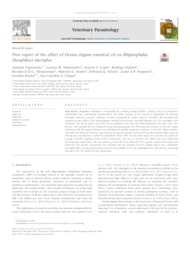First report of the effect of Ocotea elegans essential oil on Rhipicephalus (Boophilus) microplus.
First report of the effect of Ocotea elegans essential oil on Rhipicephalus (Boophilus) microplus.
Autoria: FIGUEIREDO, A.; NASCIMENTO, L. M.; LOPES, L. G.; GIGLIOTI, R.; ALBUQUERQUE, R. D. D. G.; SANTOS, M. G.; FALCÃO, D. Q.; NOGUEIRA, J. A. P.; ROCHA, L.; CHAGAS, A. C. de S.
Resumo: Rhipicephalus (Boophilus) microplus is responsible for reducing animal welfare, causing a drop in productive performance and transmitting hemoparasites. The main strategy of tick control is application of synthetic acaricides. However, parasite resistance to these compounds is a major concern. Therefore, the acaricidal and repellent in vitro effect of the Ocotea elegans essential oil on larvae and adult females of R. (B.) microplus were evaluated. The larval packet test (LPT), larval repellency test (RT) and adult immersion test (AIT) were performed. The essential oil was analyzed by gas chromatography (GC/FID) and the structure of the oil?s major constituent (92.2% sesquirosefuran) was elucidated by nuclear magnetic resonance. In the AIT, efficacy higher than 90% was detected from the concentration 25 mg/mL upward. In both LPTs performed after 48 h, only the 100 mg/mL concentration resulted in mortalities above 70%. On the other hand, the essential oil caused an average of 95.8% repellency from 0.78 to 100 mg/mL. The LC50 in the two LPT (48 h) tests were 59.68 and 25.59 mg/mL, respectively. The LC50 and LC90 in the AIT were 4.96 and 17.37 mg/mL, and in the RT they were 0.04 and 1.24 mg/mL respectively. We conclude that the essential oil of O. elegans leaves has a significant acaricidal effect on engorged females and on larval repellency of R. (B.) microplus ticks, and can be a promising alternative for the control of this ectoparasite.
Ano de publicação: 2018
Tipo de publicação: Artigo de periódico
Unidade: Embrapa Pecuária Sudeste
Palavras-chave: Carrapato de gado, Controle alternativo, Repelência, Resistência, Sesquirosefurano, Ticks
Observações
1 - Por padrão são exibidas publicações dos últimos 20 anos. Para encontrar publicações mais antigas, configure o filtro ano de publicação, colocando o ano a partir do qual você deseja encontrar publicações. O filtro está na coluna da esquerda na busca acima.
2 - Para ler algumas publicações da Embrapa (apenas as que estão em formato ePub), é necessário ter, no celular ou computador, um desses softwares gratuitos. Sistemas Android: Google Play Livros; IOS: iBooks; Windows e Linux: software Calibre.
Acesse outras publicações
Acesse a Base de Dados da Pesquisa Agropecuária (BDPA) para consultar o acervo completo das bibliotecas da Embrapa.

